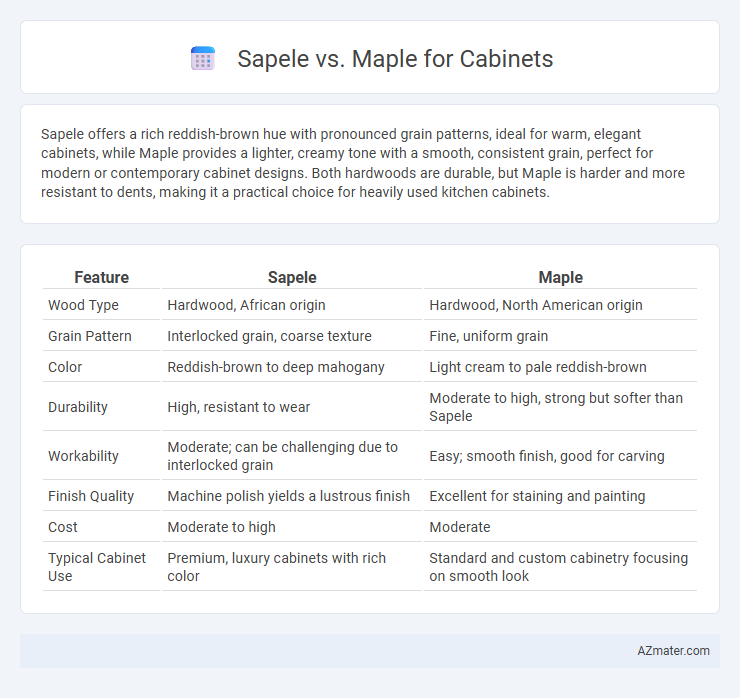Sapele offers a rich reddish-brown hue with pronounced grain patterns, ideal for warm, elegant cabinets, while Maple provides a lighter, creamy tone with a smooth, consistent grain, perfect for modern or contemporary cabinet designs. Both hardwoods are durable, but Maple is harder and more resistant to dents, making it a practical choice for heavily used kitchen cabinets.
Table of Comparison
| Feature | Sapele | Maple |
|---|---|---|
| Wood Type | Hardwood, African origin | Hardwood, North American origin |
| Grain Pattern | Interlocked grain, coarse texture | Fine, uniform grain |
| Color | Reddish-brown to deep mahogany | Light cream to pale reddish-brown |
| Durability | High, resistant to wear | Moderate to high, strong but softer than Sapele |
| Workability | Moderate; can be challenging due to interlocked grain | Easy; smooth finish, good for carving |
| Finish Quality | Machine polish yields a lustrous finish | Excellent for staining and painting |
| Cost | Moderate to high | Moderate |
| Typical Cabinet Use | Premium, luxury cabinets with rich color | Standard and custom cabinetry focusing on smooth look |
Introduction: Sapele vs Maple Cabinets
Sapele and Maple are two popular hardwood choices for cabinets, each offering distinct aesthetic and functional qualities. Sapele features a rich, reddish-brown color with a pronounced grain pattern, providing warmth and character to cabinetry. Maple offers a lighter, more uniform appearance with a smooth grain, making it a versatile option that easily complements various interior styles.
Appearance and Grain Patterns
Sapele features a rich reddish-brown hue with a natural luster and dramatic interlocking grain patterns, creating a striking, ribbon-like effect ideal for visually dynamic cabinetry. Maple offers a lighter, creamy color with a fine, uniform grain that provides a smooth, consistent appearance perfect for modern or minimalist cabinet designs. The distinct grain patterns of Sapele add warmth and depth, while Maple's subtle texture emphasizes clean lines and simplicity.
Color Variations and Aging
Sapele wood offers rich reddish-brown hues with interlocked grain patterns that deepen to a darker, more vibrant tone over time, enhancing its luxurious appearance for cabinets. Maple cabinets feature a lighter, creamy to pale yellow color that tends to darken slightly with age, developing a warm amber patina without dramatic changes. Both woods provide distinct aesthetic qualities, with Sapele delivering bold color variations and Maple offering subtle, gradual aging effects ideal for varied design preferences.
Durability and Hardness
Sapele wood exhibits a Janka hardness rating of approximately 1,410 psi, making it moderately hard and highly durable for cabinetry applications, particularly in areas prone to wear and tear. Maple, with a higher Janka hardness rating of about 1,450 psi to 1,470 psi depending on the species (hard maple being the hardest), offers exceptional hardness and resistance to dents and scratches, making it ideal for heavily used kitchen cabinets. Both Sapele and Maple provide solid durability, but Maple's slightly higher hardness ensures greater longevity under frequent use conditions.
Workability and Ease of Machining
Sapele offers moderate workability with a fine, interlocked grain that can cause occasional tear-out, requiring sharp tools and careful handling during machining. Maple, especially hard maple, provides excellent workability and ease of machining due to its uniform, straight grain and dense structure, making it ideal for precision cabinetry. Both woods respond well to sanding and finishing, but maple's predictable grain pattern generally results in smoother cuts and less tool wear.
Cost Comparison: Sapele vs Maple
Sapele wood typically costs less than maple, making it a more budget-friendly option for cabinetry without sacrificing durability. Maple cabinets can be more expensive due to their consistent grain pattern and hardness, which enhances longevity and resistance to wear. Comparing prices, sapele offers a cost-effective alternative while maple provides a higher-end look and increased strength for long-term investment.
Sustainability and Environmental Impact
Sapele wood is considered a more sustainable choice for cabinetry due to its rapid growth in West African forests and certifications from organizations like FSC, promoting responsible forestry practices. Maple, native to North America, often comes from well-managed forests but may have a higher environmental footprint due to slower growth rates and intensive harvesting. Choosing Sapele can reduce deforestation impact and support eco-friendly furniture production by utilizing a fast-renewing hardwood with lower carbon emissions during processing.
Finishing Options and Stain Absorption
Sapele wood offers a rich, reddish-brown hue that enhances with oil finishes and accepts stains evenly, producing a deep, lustrous appearance ideal for cabinets seeking warm tones. Maple presents a pale, tight-grained surface that can be challenging to stain uniformly but excels with transparent or light-colored finishes to highlight its smooth texture. Both woods require proper sanding and conditioning to achieve optimal stain absorption, with Sapele generally providing a more consistent finish due to its open grain structure.
Common Uses in Cabinetry
Sapele, a durable African hardwood with a rich reddish-brown hue, is commonly used for high-end cabinetry, offering excellent workability and a natural luster that enhances cabinet aesthetics. Maple, a North American hardwood known for its fine, consistent grain and light color, is favored for both traditional and contemporary cabinetry due to its strength and smooth finish. Both woods provide stability and resistance to warping, making them ideal choices for kitchen cabinets, built-ins, and furniture pieces.
Which Wood is Best for Your Cabinets?
Sapele offers a rich, reddish-brown hue with a dramatic grain pattern, ideal for adding warmth and elegance to your cabinets, while maple provides a lighter, uniform appearance known for its durability and smooth finish. For kitchens requiring high resistance to wear and easy staining or painting, maple's tight grain and hardness make it the best choice. Sapele is preferable if you seek a striking, exotic look and are willing to maintain its natural beauty over time.

Infographic: Sapele vs Maple for Cabinet
 azmater.com
azmater.com